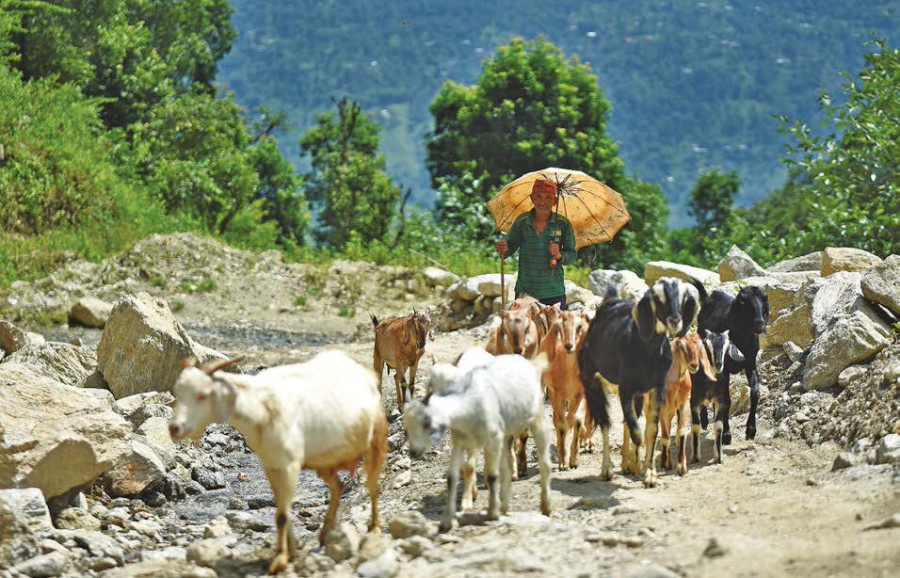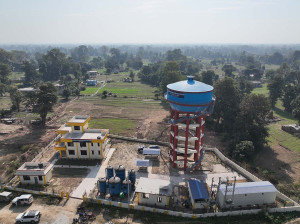Money
Old folks lonely but happy in empty mountain villages
The old generation is glad to see their migrant children are getting a better life than they had, and sending some money back home from time to time.
Sangam Prasain
Bhedpu village, which lies in the Himalayan foothills about 200 km northeast of Kathmandu, has been denuded of its young men and women. They have all gone abroad to work in high-paying jobs.
Som Bahadur Tamang has been living alone in the village, which forms part of Melung Rural Municipality, Dolakha, for the last seven years.
Once, his house bustled with nine family members. His wife died last year.
Last week, the 65-year-old Tamang was sitting under the hot summer sun, cutting grass for his buffalo.
Next to him, a mobile phone rings. It’s an Apple iPhone 13 Pro Max, one of the most expensive sets in the world.
“My son brought it from Japan,” Tamang told the Post. “He lives in Japan. He came home last week after seven years.”
Apart from the 24-year-old son, Tamang has six daughters, all of whom are married and live in different cities in the country and abroad.
Tamang says he is alone, but he is happy.
Two decades ago, he toiled to feed his family of nine. He remembers how exhausted he would be, the strenuous work often bringing him to tears.
He struggled to educate his children with the little money he earned.
“My son passed grade 12 and decided to go abroad. Among my six daughters, three have passed School Leaving Certificate and the others have studied up to grade eight,” Tamang said.
Gyan Bahadur Tamang, 65, is another senior resident who has seen all his children leave the village.
Father of five daughters and a son, Tamang is proud that his children live in cities. His son has gone abroad.
“My son spent five years in Australia and moved to Finland. He is a driver there,” said Tamang of Bhedpu-4.
“Normally, I talk with my children daily through free phone and video calls. Our village is literally empty. Keta heru kohi chhainna (there are no boys),” he said.
“Life is difficult in the village. Why should people stay here? I may be alone here, but my children are happy in the cities and foreign countries.”
The life of these two old Tamang men reflects the bitter reality of our present society.
“Everyone is leaving. That’s a sad part of our village story,” said Hira Kumar Tamang, chairman of Melung Rural Municipality.
“At this pace, after five years, we won’t see anybody below 40 years in the village. It's going to happen.”
As per a report of the Nepal Rastra Bank, the central bank, one of the country's major exports is labour, and most rural households now rely on at least one member's earnings from employment away from home.
The number of Nepali migrant workers who obtained approval for foreign employment in the last fiscal year reached 774,976 individuals—the highest out-migration on record.
Nepali workers have sought foreign employment as both agricultural and non-agricultural sectors struggle to generate new jobs.
With limited arable land, landlessness is pervasive, and the number of landless households has steadily increased in the farm sector.
In the non-agricultural sector, the slowdown in growth, especially since 2000-01 due to the Maoist insurgency which killed more than 17,000 people, further retarded the pace of employment creation, according to the central bank’s report.
Political unrest in the country adversely affected economic growth. There has been a steady growth in infrastructure, but they are tardy and costly. Due to endemic irregularities, it takes more than a decade for the construction of any medium-scale project, analysts say.
According to the central bank, for most of the past decade, the economic growth rate hovered around a mere 3-4 percent, peaking in 2007-08 at 6 percent, following the Comprehensive Peace Accord between the Maoists and the government in 2006.
Then followed a period of severe power shortages when Nepalis were forced to live without electric lighting. Between 2007 and 2017, the country went through a massive electricity shortage that caused up to 18 hours of daily power outages.
Currently, the country is crippled by political uncertainty. Every successive administration is enmeshed in corruption. Investment in the manufacturing and agriculture sectors is low. As a result, a farming country has started importing foods worth billions.
In remote Dolakha, it is rare to see youths because of the economic changes that have come upon the country—a shift from rural to predominantly urban lifestyles.
The stone and clay walls of the village houses are amazingly beautiful, but no one lives in them. Most of the houses in Melung Rural Municipality are permanently locked.
About a two-hour drive uphill from the Tamakoshi River bridge, empty villages come into view on the mountain slopes.
Most areas are covered in lush green forests. They stand as a reminder of how fast these places are turning into ghost towns.
Hira Kumar, chairman of the rural municipality, says out-migration from the villages has reached dangerous levels.
“In the past decades, migrant workers used to come home during the holidays and then return to their jobs abroad. These days, students are leaving. They aren't coming back.”
Hira Kumar says the rural municipality is inundated with applications from students for property valuation of their houses, one paperwork they need to go abroad.
“We cannot stop them,” he says.
Nepal has progressed a lot in terms of infrastructure development. There are adequate roads, electricity and basic health education and internet facilities all over Nepal.
“But the human development index is poor,” said Hira Kumar. He says a comprehensive national policy is needed to stop the exodus.
According to the Ministry of Education, 110,217 students obtained No Objection Certificates (NOC) for foreign study in the last fiscal year ended July 16, a fourfold jump in 10 years.
Australia, Japan, Canada, the United Kingdom and the United States, in that order, are the top five destinations for Nepali students.
Of the total number of NOCs issued in the last fiscal year, 33,991 were for Australia, 21,658 for Japan, 21,544 for Canada, 10,527 for the UK and 3,970 for the US, according to the ministry.
The central bank said that Nepalis spent Rs144.46 billion on foreign travel, including Rs100.42 billion for education, in the last fiscal year.
Driving through the villages of Melung in the evening, one is greeted with charming scenes.
Old women and men return from the forest with loads of grass on their backs with their livestock following them.
In Melung, men are scarce.
“Females do the work of males here,” said Gayatri Acharya, vice-chairman of Melung Rural Municipality. “Women are leading the households. They have to.”
An increasing number of female-headed households are emerging in Nepal as a result of economic downturns and exodus of males to foreign lands.
In 2011-12, female-headed households, in which an adult female became the sole or main income producer and decision-maker, made up only 19 percent of the households in Nepal.
After 10 years, according to the agriculture census report released recently, female-headed holdings had nearly doubled to 32.4 percent. This means 1.33 million women head households in Nepal.
“The migration trend may change soon. Women are also going abroad,” said Acharya.
Different local governments are launching schemes to retain youths in agriculture.
In Melung too, a number of skill-based training and other agriculture and livestock-focused programmes to help farmers, particularly women, to increase incomes have been launched, said Acharya. “But it’s not easy.”
The rural municipality has roped in Heifer International Nepal, a global development organisation on a mission to end hunger and poverty, to help farmers.
Prabin Gurung, knowledge management and communication manager at Heifer International Nepal, says they have launched an agriculture and livestock project in remote Dolakha as per the request from the local government.
“Our project aims to make women financially independent. We provide them skill-based training and encourage them to start their own businesses.”
Heifer Nepal works with women farmers.
It has been helping farmers to increase meat and milk productivity and connect the rural economy to the urban economy.
“We work under a 70:30 partnership scheme. Heifer supports 30 percent of the project investment,” said Gurung. “Our model basically avoids making farmers dependent on subsidies and donations. We look for a sustainable solution.”
Sobha Basnet Karki, chairman of Urjasil Women’s Group under the Heifer programme, said they received training to become independent. The programme started in March.
Heifer normally provides cattle as a gift to the farmers who have to pass them on to others.
In Melung, farmers are constructing a chilling centre.
Ram Krishna Bhandari, chairman of Melung Rural Municipality Ward No 2, said they were in the final phase of launching a dairy that will help farmers increase income.
In Ward 2, they collect 300 litres of milk daily. Plans are to increase the collection to 900 litres a day.
“We are optimistic that the dairy project will boost farmer incomes from Rs15,000 to Rs30,000 a month,” said Bhandari.
Youths have not been enthusiastic about the agriculture industry for several reasons–low income and low regard by society.
The prospects of agricultural growth are being seen as the responsibility of the ageing rural population. Experts say it is practically impossible for the old generation to deliver the expected productivity.
“Encouraging young people to venture into agriculture is important, as it presents a huge opportunity to reduce youth unemployment,” said Bhandari. “But how, that is always a big question.”




 8.12°C Kathmandu
8.12°C Kathmandu













